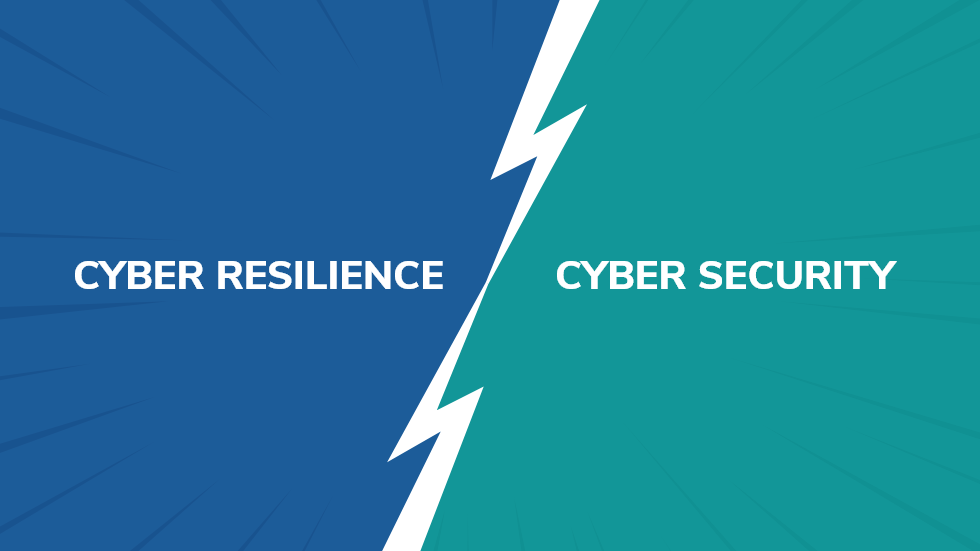In today’s digital landscape, organizations face an ever-growing risk of cyber threats, ranging from data breaches to disruptive incidents that can halt their operations. Safeguarding sensitive information and maintaining operational continuity have become critical imperatives for businesses worldwide.
Two concepts that play a crucial role in fortifying cybersecurity defenses are “cyber resilience” and “cyber security.” Although these terms are often used interchangeably, it is important to understand their nuanced differences and how they contribute to an organization’s overall security strategy.
Cyber Security:
Cyber security encompasses the comprehensive measures and practices implemented to protect computer systems, networks, and data from unauthorized access, malicious activities, and potential damage. It focuses on preventing and mitigating immediate threats and ensuring critical information’s confidentiality, integrity, and availability.
Key Aspects of Cyber Security:
Cyber security has some key aspects that differentiate it from cyber resilience.
1. Threat Prevention:
Cyber security strategies involve deploying preventive measures to thwart unauthorized access and mitigate potential threats. This includes implementing robust firewalls, intrusion detection systems, access controls, and encryption techniques to secure sensitive information from malicious actors.
2. Vulnerability Management:
A crucial aspect of cyber security is vulnerability management, which involves identifying weaknesses in systems and networks through regular assessments. Organizations can significantly reduce the risk of cyberattack exploitation by promptly addressing and patching these vulnerabilities.
3. Incident Response:
Cyber security incorporates incident response plans to handle security breaches and cyber-attacks effectively. It entails establishing incident response teams, defining communication channels, and utilizing incident detection and response tools to minimize the impact of incidents and facilitate swift recovery.
4. Security Awareness and Training:
A strong cyber security program emphasizes educating employees and users about best practices, recognizing potential risks, and maintaining good cyber hygiene. By fostering a security-conscious culture and promoting awareness of threats like phishing attempts or social engineering, organizations can bolster their defense against cyber attacks.
Cyber Resilience:
 In contrast to cyber security, cyber resilience takes a broader approach, focusing on an organization’s ability to adapt, respond, and recover from cyber-attacks or disruptive incidents while maintaining business continuity. Cyber resilience entails developing comprehensive business continuity plans, effective risk management practices, incident adaptability, and stakeholder collaboration. It ensures that organizations can withstand and recover from cyber incidents, minimize downtime, and swiftly restore normal operations.
In contrast to cyber security, cyber resilience takes a broader approach, focusing on an organization’s ability to adapt, respond, and recover from cyber-attacks or disruptive incidents while maintaining business continuity. Cyber resilience entails developing comprehensive business continuity plans, effective risk management practices, incident adaptability, and stakeholder collaboration. It ensures that organizations can withstand and recover from cyber incidents, minimize downtime, and swiftly restore normal operations.
Key Aspects of Cyber Resilience:
1. Business Continuity Planning:
Cyber resilience prioritizes developing robust business continuity plans to minimize disruptions in the face of cyber attacks. This involves identifying critical functions, establishing redundant systems, and formulating strategies for backup and recovery, enabling organizations to sustain essential services during challenging times.
2. Risk Management:
Cyber resilience incorporates robust risk management practices, including regular assessments and the implementation of appropriate mitigation strategies. By understanding vulnerabilities and prioritizing risks, organizations can proactively address weaknesses and reduce the impact of potential cyber threats.
3. Incident Adaptability and Recovery:
Cyber resilience acknowledges that no defense is foolproof, and incidents may still occur. Therefore, it emphasizes an organization’s ability to adapt, respond, and recover quickly. This includes establishing effective incident response teams, conducting post-incident analysis to learn from attacks, and continually updating security measures based on emerging threats.
4. Stakeholder Collaboration:
Cyber resilience encourages collaboration among stakeholders, such as IT teams, business units, and external partners. Organizations can coordinate response efforts, share knowledge, and ensure a comprehensive approach to mitigating cyber threats by fostering a collective understanding of cyber risks.
Building a Cyber Resilience and Cyber Security Program:

To effectively address cyber threats and protect an organization’s assets, it is crucial to establish a comprehensive cyber resilience and cyber security program. Here are the key steps to building such a program:
1. Assess Organizational Needs:
Begin by thoroughly assessing the organization’s cybersecurity requirements, risk tolerance, and existing security measures. This assessment should identify vulnerabilities, evaluate potential impact, and determine the necessary resources for an effective program.
2. Develop a Strategy:
Define clear objectives and goals for cyber resilience and security. Formulate a strategy that outlines the necessary initiatives and steps to enhance security measures, improve incident response capabilities, and ensure business continuity. Align the strategy with organizational priorities and risk appetite.
3. Implement Protective Measures:
Deploy a range of security controls and technologies to prevent unauthorized access, detect potential threats, and mitigate vulnerabilities. This includes implementing firewalls, intrusion detection systems, access controls, encryption, and multi-factor authentication. Regularly update and patch software to address emerging vulnerabilities.
4. Foster a Security Culture:
Promote a culture of security awareness throughout the organization. Conduct regular training sessions to educate employees about cyber risks, best practices, and incident reporting procedures. Encourage a proactive approach to cybersecurity and engage employees in safeguarding sensitive information.
5. Establish Incident Response and Recovery Processes:
Develop and test incident response plans to address and mitigate cyber incidents effectively. Establish clear roles and responsibilities, define communication channels, and conduct simulated exercises to improve incident response capabilities. Implement backup and recovery mechanisms to restore operations swiftly.
6. Continuously Monitor and Improve:
Regularly assess the effectiveness of cyber resilience and security measures. Stay updated on emerging threats and industry best practices. Conduct periodic risk assessments, vulnerability scans, and penetration tests to identify and address weaknesses promptly. Regularly evaluate the program’s performance and make adjustments as needed.
Benefits of Cyber Resilience for Large Corporations:

With cyber-attacks being an ever-looming threat, large corporations can benefit greatly from a robust cyber resilience strategy. Here are some of the benefits that a good cyber resilience strategy can have for firms:
1. Enhanced Protection of Sensitive Information:
Large corporations handle vast amounts of sensitive data. Implementing a robust cyber resilience program ensures heightened protection for this data, minimizing the risk of breaches, intellectual property theft, and unauthorized access. This helps maintain customer trust and regulatory compliance.
2. Improved Business Continuity:
Cyber resilience strongly emphasizes comprehensive business continuity planning. For large corporations, maintaining uninterrupted operations is vital. With strategies to rapidly recover from cyber incidents, large corporations can minimize downtime, financial losses, and reputational damage.
3. Heightened Incident Response Capabilities:
Large corporations often face sophisticated and targeted cyber attacks. A robust cyber resilience program equips them with the necessary incident response capabilities to swiftly detect, contain, and mitigate cyber incidents. This enables a proactive and effective response to minimize the impact on business operations.
4. Compliance with Complex Regulations:
Large corporations operate across various jurisdictions, making compliance with complex data protection and cybersecurity regulations crucial. A well-designed cyber resilience framework ensures adherence to these regulations, reducing the risk of regulatory fines, legal liabilities, and damage to corporate reputation.
5. Strengthened Stakeholder Trust:
Large corporations have extensive relationships with customers, partners, and investors. Demonstrating a commitment to cyber resilience enhances stakeholder trust by showcasing a proactive approach to protecting sensitive information and maintaining operational continuity. This fosters stronger business relationships and provides a competitive advantage.
Final Thoughts:
Understanding the difference between cyber resilience and cyber security is crucial for organizations aiming to protect sensitive information and maintain operational continuity. By integrating strong cyber resilience strategies with effective cyber security measures, organizations, especially large corporations, can enhance their preparedness, adaptability, and ability to withstand and recover from cyber threats. Building a comprehensive program involves:
- Assessing organizational needs.
- Developing a strategy.
- Implementing protective measures.
- Fostering a security culture.
- Establishing incident response processes.
- Continuously monitoring and improving the program.
For large corporations, the benefits of cyber resilience include enhanced protection of sensitive information, improved business continuity, heightened incident response capabilities, compliance with complex regulations, and strengthened stakeholder trust. Embracing a comprehensive approach encompassing both cyber resilience and cyber security is the key to safeguarding critical assets and maintaining a strong defense against evolving cyber threats.

Santiago Montoya, a seasoned DevOps engineer with a Eight-year tenure in the field, brings a wealth of experience. Santiago is a true visionary in the tech realm and holds the Global Director of Technology position at TechGenies. His expertise spans diverse domains, from cybersecurity and solution architecture to IT cost optimization. As a HIPAA-certified AWS Solutions Architect, he ensures top-tier security and architects robust solutions that transcend industry standards. Santiago is the driving force behind TechGenies’ technological prowess, orchestrating a symphony of innovation and efficiency.
Connect with Santiago to explore the intricacies of modern technology leadership and discover how he continues to shape the landscape of IT excellence.



